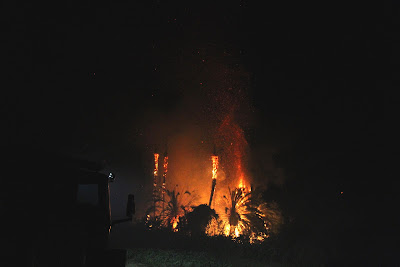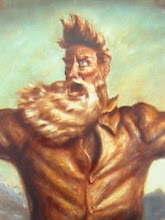As the fire is waning, so is the daylight. The helicopters are continuing their work, hurrying to complete as many drops as possible before darkness falls and they stop flying.
Although he large bodies of fire have been extinguished, thousands of smoldering hot-spots remain. They produce lots pf smoke, but not enough heat to cause the smoke to rise in the hot fall air. The resulting blanket of smoke is not unlike fog, only smelling much worse.
As darkness nears, the crews start thinking about the next operational period. Who gets to go home, who has to stay and mop up the fire overnight. One hopes a rational system is used to determine who stays, but often it seems like it is just a random decision.
Frankly, fires in the area are a complete pain in the ass. The vegetation is a jungle-like matte of vines, shrubs and trees. Moving through it is hazardous in daylight, doubly so in the dark. Burned out trees present a hazard to the firefighters, the falling branches and trunks are called widow makers for a reason. Footing is always treacherous, the uneven terrain, clinging vines and dense vegetation make each step like taking twenty.
Just as the sun drops below the horizon, a decision is reached at the command post and we receive word that we have been selected to work the night shift. We are assigned to overhaul a stretch of road about a quarter mile long, 200 feet into the burn. Other engines are responsible for similar sections of the fire and several units have extended hose lays thousands of feet into the center of the burn.
We begin working our section of the roadside. Progress is slow. Roots, logs and poor water supply impede our progress. Each smoker within 200 ft. of the roadside must by dug up and extinguished. Steam from the water mixes with smoke to reduce visibility. Ash drifts through the air, disturbed by our footsteps and carried by the wind.
Cel-phone photo
We toil for hours, digging, spraying and pulling hose. Our progress can be measured by how far we move along the road. We can hear the hand crews sawing their way through to the center of the burn. Occasionally, we speak with the units on both sides of us, each with similar challenges.
Every so ofter, another palm tree torches off, sending more embers into the sky, increasing the chances of spot fires outside of the control line.
Cell phone photo
Finally, around one or so, our objective has been roughly met. We are all tired, we have been on scene for 12 hours and are starting to make silly mistakes. I decide to stop operations and just monitor our section of the line.
As it is a cool night, we try to find a position of comfort in our seats and cat-nap. Every half hour, I get up and walk our section. On two occasions, we pour water on to a stubborn, smoldering root system and tree trunk that has been giving us trouble all night.
The tree and several branches are severely burned through, working under them is asking for trouble. I opt to have the crew apply water from afar until we can get a faller in there to remove the hazard.
Finally, dawn rolls around and the sky goes from black to gray to blue. I walk the length of the line, meeting up with the other crews. We are told that we will be relieved soon and pick up our hose and equipment.
The day shift arrives and we are released. Back to quarters we go, clean-up and showers before heading home.
All of the big plans that I have for the day are canceled, sleep and laundry is the order of the day. Fortunately, all - nighters for me are rare. I like it that way.
Thanks for reading,
Schmoe








No comments:
Post a Comment